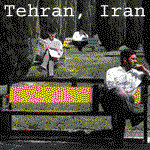How urgent are U.S. "emergency" Iraq funds?
 (L-R) President Felipe Calderon of Mexico, United States President George W. Bush and Canadian Prime Minister Stephen Harper stand together after a press conference during the North American Leader's Summit on 22 April 2008 at Gallier Hall in New Orleans, Louisiana.
(L-R) President Felipe Calderon of Mexico, United States President George W. Bush and Canadian Prime Minister Stephen Harper stand together after a press conference during the North American Leader's Summit on 22 April 2008 at Gallier Hall in New Orleans, Louisiana. By Richard Cowan
Buried in President George W. Bush's 159-page request for additional war funding are plans to give the Pentagon $230 million (115 million pounds) for an F-35 Joint Strike Fighter aircraft purchase.
That's a small portion of the more than $100 billion in war funds the Bush administration wants Congress to pass. White House Budget Director Jim Nussle told lawmakers last week that failure to do so by late May would harm Pentagon operations.
But it is part of a Pentagon strategy to help modernize a war-sapped military with money outside its regular budget.
Nussle's urgent appeal failed to note that Lockheed Martin's F-35 Joint Strike Fighter is still in the developmental stage, not entering service until around 2013.
The F-35 has been in the works since at least 1993, so it's not exactly an unexpected cost of war in Iraq or Afghanistan, which the emergency spending claims to address.
The Pentagon said the F-35 funding request was relevant because the fighters will replace F-16 jets lost in Iraq.
"We don't feel that it makes sense to replace existing losses with old technology," said Pentagon spokesman Bryan Whitman. He acknowledged the Pentagon might have considered replacing lost F-16s with technology now available if war losses, and therefore the need for replacements, was greater.
Placing some longer-term expenditures in emergency war-funding bills is a way of getting around caps on the Defence Department's regular spending and "makes more money available in the regular budget to meet cost overruns," said Amy Belasco, a Congressional Research Service Defence analyst.
Chronically, major Pentagon projects have exceeded cost projections, according to government auditors.
Besides the F-35 request, the Pentagon wants $492.5 million in "emergency" funds to buy the Air Force five CV-22 Osprey aircraft that can take off and hover like a helicopter and make long-distance flights like an airplane.
The aircraft, manufactured by Bell Helicopter Textron Inc. and Boeing Co., will not be operational until 2009 at the earliest, with a total of 50 CV-22 aircraft delivered by 2017, according to the U.S. Air Force.
Another high-tech aircraft, Boeing's EA-18G Navy plane, would get $375 million. But this precision attack aircraft also won't even become operational for another year.
Democrats running for president are promising that if they occupy the White House in January, they will immediately begin phasing out the war in Iraq and possibly have it over with before some of these weapons are widely available.
THE UNCERTAINTIES OF WAR?
These supplemental war funds requests, sent to Congress the past seven years, are dubbed emergencies by supporters who argue they are to pay for combat operations that can't be planned in regular budgets due to the uncertainties of war.
Without the money, U.S. combat soldiers would run out of ammunition, fuel and tanks to fight in Iraq and Afghanistan.
The money is on top of about $500 billion that Congress annually gives the military for its regular operations.
Increasingly, the Pentagon has tucked into the "emergency" bills requests for hardware and personnel with questionable relevance to the combat the measures are supposed to fund.
"There will be people trying to get it stripped out" this time around, said Sen. Ben Nelson, the Nebraska Democrat who serves on the Senate panels overseeing military budgets.
There are concerns in the House of Representatives too.
At a hearing of the House Budget Committee, Republican Rep. Paul Ryan of Wisconsin asked Pentagon officials about long-term military costs increasingly being paid with war monies.
"Why has the spending increased by 140 percent over the last seven years in the procurement, research and development, test and evaluation accounts" of war funding, Ryan wondered.
The non-partisan Congressional Budget Office, in a February 11 analysis of escalating war costs, observed that before 2005, war funds mostly were to deploy troops, transport equipment and buy fuel, spare parts and munitions.
But starting in 2005, CBO said, instead of just repairing war-damaged equipment, the Pentagon began using emergency war funds to replace such equipment with "newer models" while also accelerating "planned purchases of new systems."
The controversial practice is embraced by Democratic Rep. John Murtha of Pennsylvania, who chairs a powerful Defence spending panel. Saying the Iraq war that he now opposes is "stretching our forces thin and destroying our readiness," Murtha argued that using the emergency bills to help buy future weapons systems will help "prepare our military and nation to face threats down the road."
Labels: Afghanistan, Bush, Iraq, United States, War














0 Comments:
Post a Comment
<< Home